Encoding intensity in ventral cochlear nucleus following acoustic trauma: implications for loudness recruitment
- PMID: 18855070
- PMCID: PMC2644394
- DOI: 10.1007/s10162-008-0142-y
Encoding intensity in ventral cochlear nucleus following acoustic trauma: implications for loudness recruitment
Abstract
Loudness recruitment, an abnormally rapid growth of perceived loudness with sound level, is a common symptom of sensorineural hearing loss. Following acoustic trauma, auditory-nerve rate responses are reduced, and rate grows more slowly with sound level, which seems inconsistent with recruitment (Heinz et al., J. Assoc. Res. Otolaryngol. 6:91-105, 2005). However, rate-level functions (RLFs) in the central nervous system may increase in either slope or saturation value following trauma (e.g., Salvi et al., Hear. Res. 147:261-274, 2000), suggesting that recruitment may arise from central changes. In this paper, we studied RLFs of neurons in ventral cochlear nucleus (VCN) of the cat after acoustic trauma. Trauma did not change the general properties of VCN neurons, and the usual VCN functional classifications remained valid (chopper, primary-like, onset, etc.). After trauma, non-primary-like neurons, most noticeably choppers, exhibited elevated maximum discharge rates and steeper RLFs for frequencies at and near best frequency (BF). Primary-like neurons showed the opposite changes. To relate the neurons' responses to recruitment, rate-balance functions were computed; these show the sound level required to give equal rates in a normal and a traumatized ear and are analogous to loudness balance functions that show the sound levels giving equal perceptual loudness in the two ears of a monaurally hearing-impaired person. The rate-balance functions showed recruitment-like steepening of their slopes in non-primary-like neurons in all conditions. However, primary-like neurons showed recruitment-like behavior only when rates were summated across neurons of all BFs. These results suggest that the non-primary-like, especially chopper, neurons may be the most peripheral site of the physiological changes in the brain that underlie recruitment.
Figures
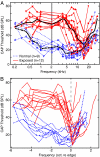

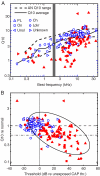
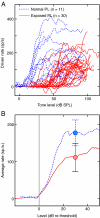
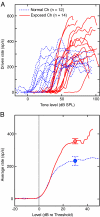
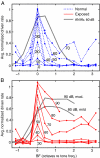
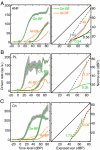


Comment in
-
Recruitment of neurons and loudness. Commentary on "Encoding intensity in ventral cochlear nucleus following acoustic trauma: implications for loudness recruitment" by Cai et al. J. Assoc. Res. Otolaryngol. DOI: 10.1007/s10162-008-0142-y.J Assoc Res Otolaryngol. 2009 Mar;10(1):1-4. doi: 10.1007/s10162-009-0156-0. Epub 2009 Jan 22. J Assoc Res Otolaryngol. 2009. PMID: 19159978 Free PMC article. No abstract available.
References
-
- None
- Allen JB. Derecruitment by multiband compression. In: Jesteadt W (ed) Modeling Sensorineural Hearing Loss. London, Erlbaum, 1997.
-
- {'text': '', 'ref_index': 1, 'ids': [{'type': 'PubMed', 'value': '2600627', 'is_inner': True, 'url': 'https://pubmed.ncbi.nlm.nih.gov/2600627/'}]}
- Blackburn CC, Sachs MB. Classification of unit types in the anteroventral cochlear nucleus: PST historgrams and regularity analysis. J. Neurophysiol. 62:1303–1329, 1989. - PubMed
-
- Bourk TR. Electrical Responses of Neural Units in the Anteroventral Cochlear Nucleus of the Cat. Unpublished doctoral thesis. Department of Electrical Engineering and Computer Science, Massachusetts Institute of Technology, Cambridge, MA, 1976.
-
- {'text': '', 'ref_index': 1, 'ids': [{'type': 'DOI', 'value': '10.1007/s101620010084', 'is_inner': False, 'url': 'https://doi.org/10.1007/s101620010084'}, {'type': 'PMC', 'value': 'PMC3202402', 'is_inner': False, 'url': 'https://pmc.ncbi.nlm.nih.gov/articles/PMC3202402/'}, {'type': 'PubMed', 'value': '12162363', 'is_inner': True, 'url': 'https://pubmed.ncbi.nlm.nih.gov/12162363/'}]}
- Buus S, Florentine M. Growth of loudness in listeners with cochlear hearing losses: recruitment reconsidered. J. Assoc. Res. Otolaryngol. 3:120–139, 2002. - PMC - PubMed
-
- Cai S. Intensity encoding of ventral cochlear nucleus neurons in normal and deafened cats and correlates of loudness recruitment. Unpublished Master’s thesis. Department of Biomedical Engineering. The Johns Hopkins University, Baltimore, MD, 2007.
Publication types
MeSH terms
Grants and funding
LinkOut - more resources
Full Text Sources
Miscellaneous

